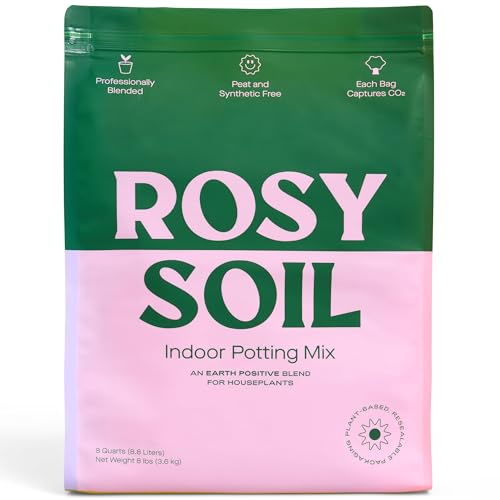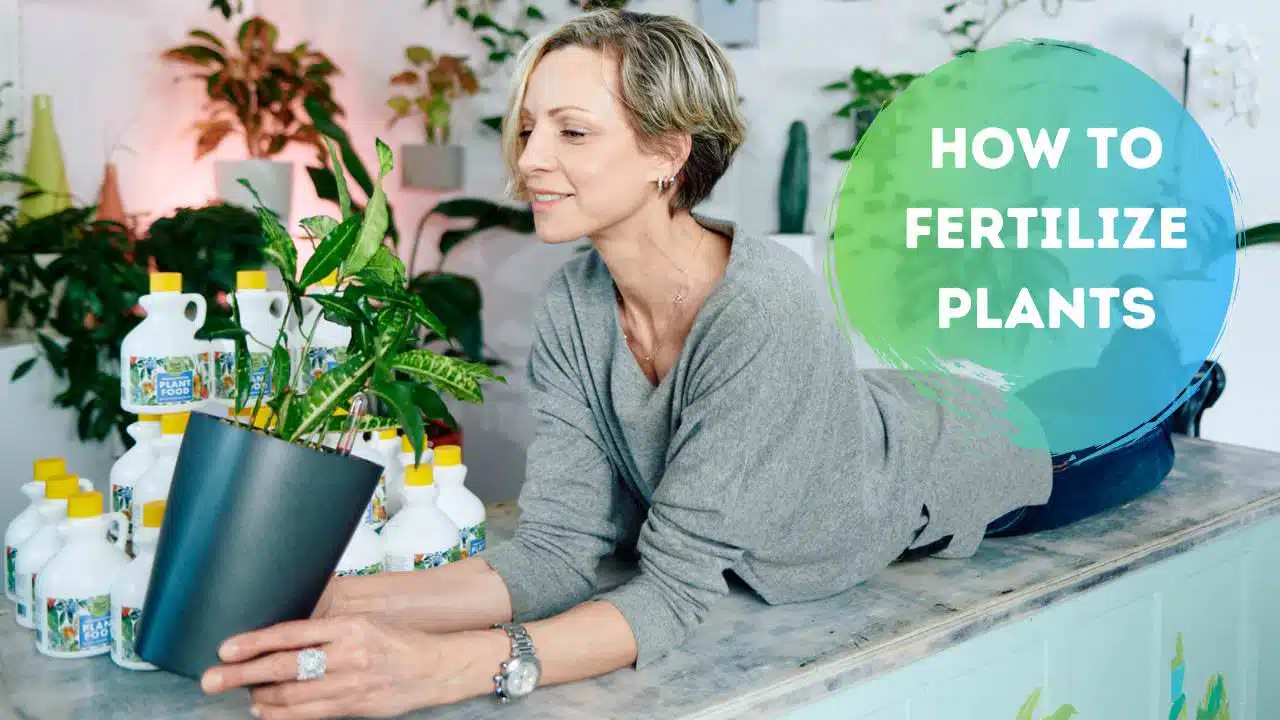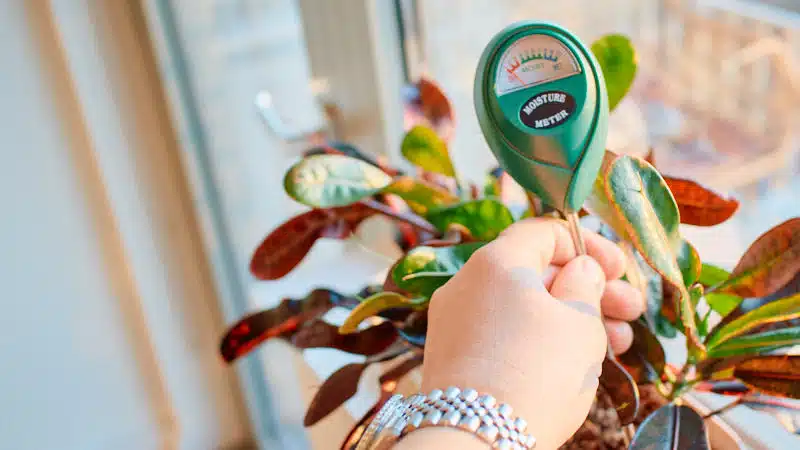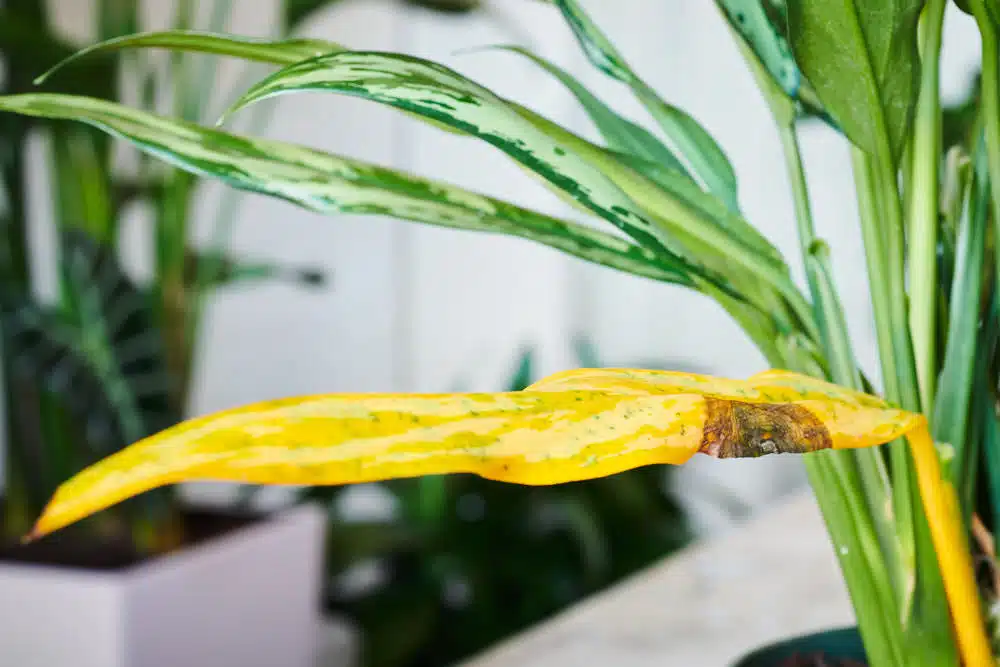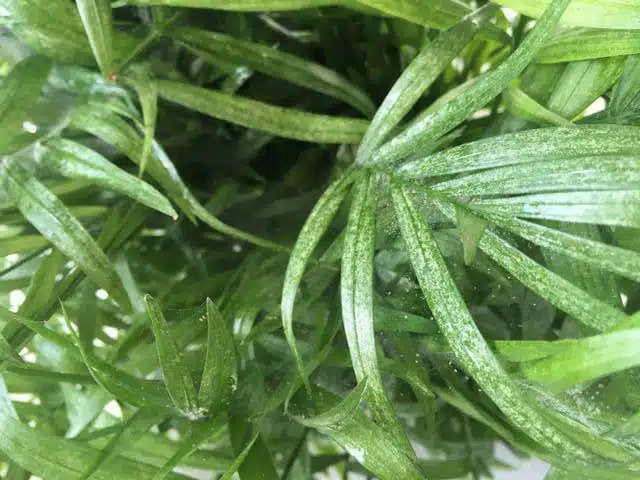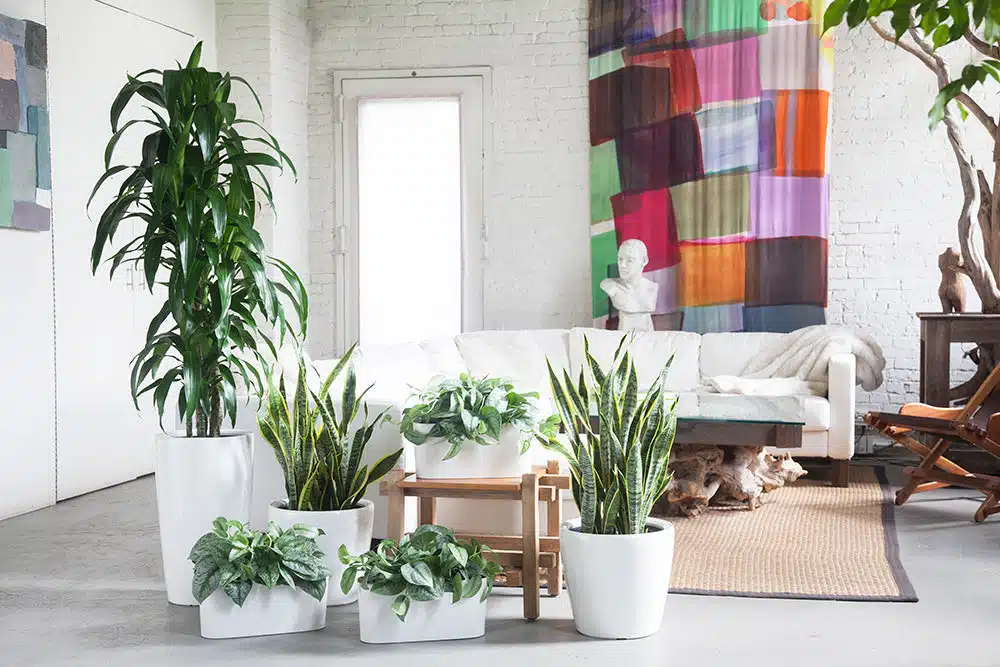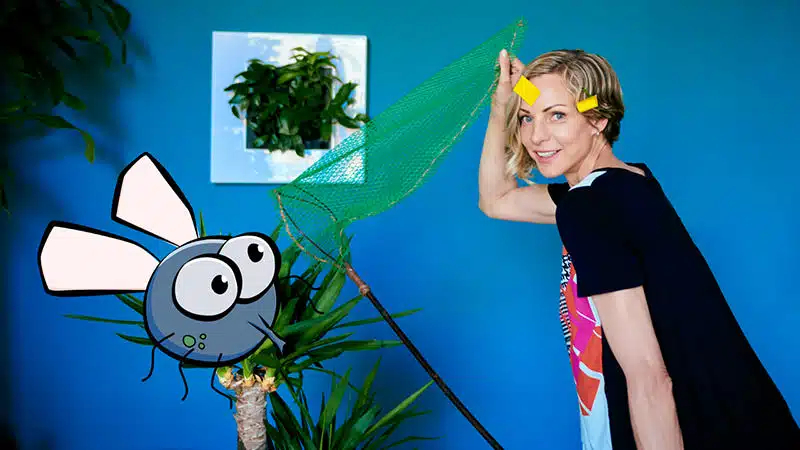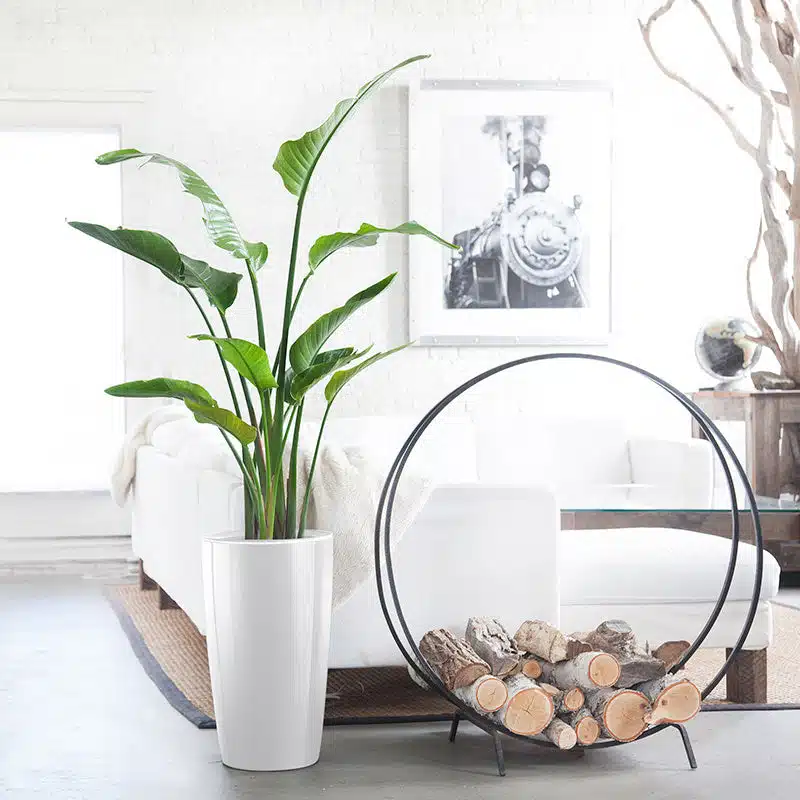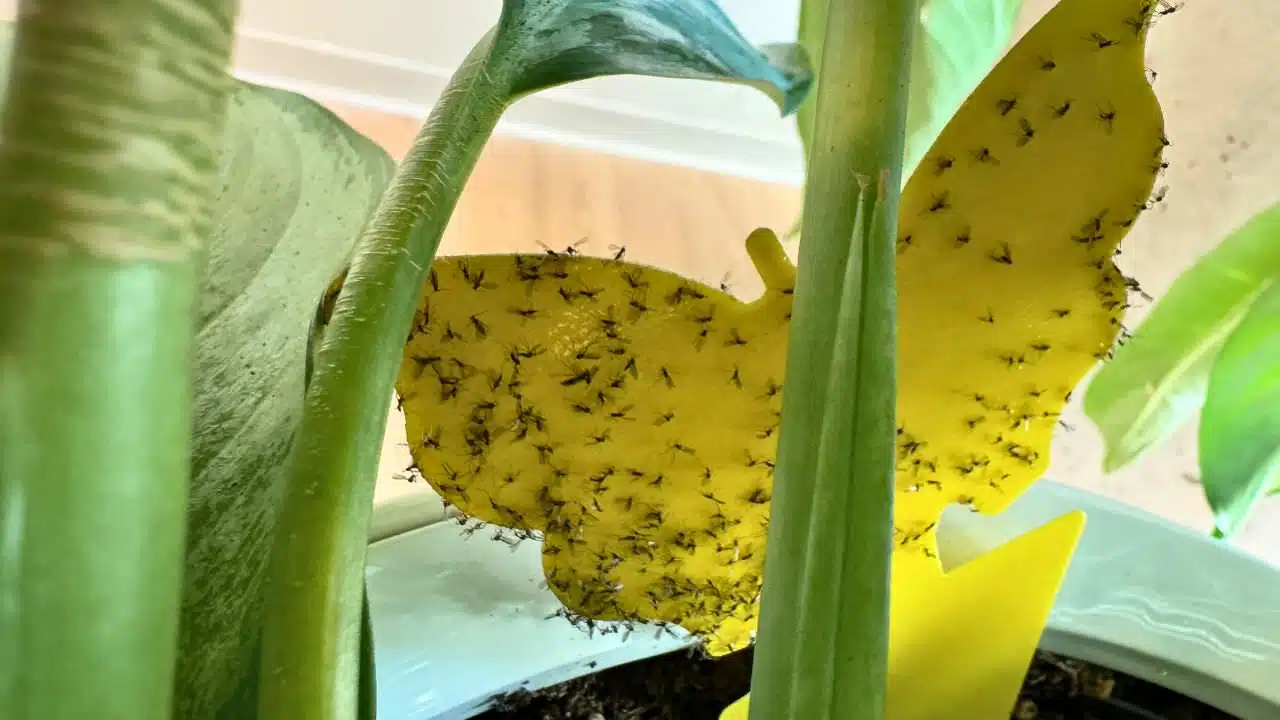
Are gnats buzzing around your beloved houseplants driving you crazy? You’re not alone! I’ve faced these pesky little terrors countless times, and I’m here to share my tried-and-true methods to get rid of gnats in plants for good.
Why trust me with your gnat problem? As the owner of a plant care company in New York City, my professional team and I care for thousands of plants in all kinds of challenging commercial spaces.
When it comes to pest infestations, I’ve seen and dealt with them all: gnats, mealybugs, spider mites, scale, you name it. Over the past 20 years, I’ve tested countless treatment options, saving thousands of plants (though I must admit, not every treatment worked, and some plants didn’t make it).
I’m always learning and trying new ways to fight off gnats and other uninvited pests.
If you’re wondering how to get rid of gnats in your plants, you’re in the right place.
In this complete guide, I’ll walk you through everything you need to know about identifying, preventing, and treating gnat infestations in plants.
You’ll learn how to recognize gnats, understand their life cycle, and discover effective ways to eliminate them for good. Whether you’re dealing with a minor gnat problem or a full-blown infestation, this guide has all the tools and strategies you need to keep your houseplants happy and gnat-free.
I encourage you to bookmark this post, as I’ll be updating it from time to time with new methods and discoveries.
What Are Fungus Gnats?
Let me tell you, fungus gnats are the bane of many indoor plant enthusiasts’ existence. These little troublemakers are attracted to moist soil, which is exactly what we provide our plants. They’re especially fond of potting mixes with lots of organic matter, like peat moss. It’s like we’re rolling out the red carpet for them!
First things first, gnats only survive and breed in constantly moist soil.
If your plant is playing host to these pests, it’s a clear sign you’ve been over-watering.
I know, I know, we all want to shower our plants with love, but too much water creates the perfect breeding ground for these pests. They lay their eggs in damp soil, and before you know it, you’ve got a full-blown gnat party on your hands.
While gnats are much less of a headache to treat compared to spider mites or mealybugs, they’re not to be ignored.
Now, you might be thinking, “They’re just tiny flies, what’s the big deal?” Well, let me tell you, it’s not just about the annoying adults buzzing around your face. The real troublemakers are the larvae that hang out in the soil. These little grubs feed on plant roots and organic matter, which can seriously harm your plants.
When the infestation escalates, the health of your plant’s root system is at risk, often accompanied by root rot.
Detecting Fungus Gnats
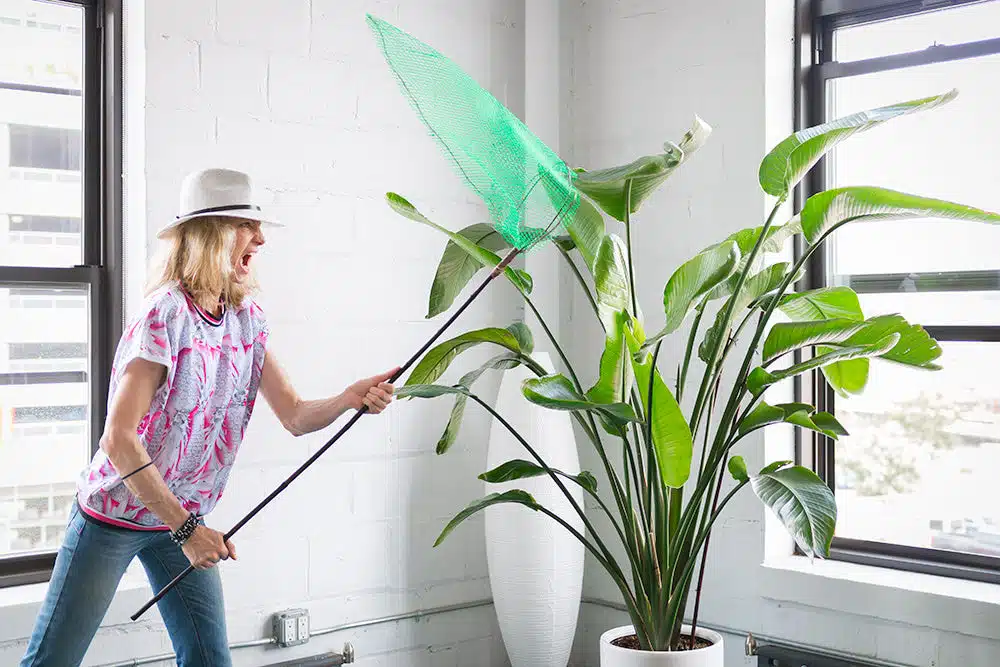
Alright, plant pals, let’s talk about spotting these pesky little invaders. Detecting fungus gnats early can save you a lot of headaches down the road. Trust me, I’ve been there, and I’m here to share my gnat-detecting wisdom with you!
The Telltale Signs
First things first, keep an eye out for tiny flying insects near your plants, especially around windows or light sources. These little guys are about 1/8 inch long and look like miniature mosquitoes. If you see them doing a clumsy dance around your plants when you water, that’s a red flag!
But here’s the kicker – it’s not just the adults you need to watch for. The real troublemakers are hiding in the soil. Look for slime trails on the soil surface – it’s like they’re leaving behind their tiny, gross autographs. If you’re brave enough to dig a little, you might spot 1/4-inch-long worms in the top few inches of soil. These are the larvae, and they’re the ones doing the real damage to your plant’s roots.
Plant Symptoms To Watch For
Now, let’s talk about what your plants might be telling you. If you notice sudden wilting, stunted growth, or yellowing leaves, don’t just blame your watering habits. These could be signs that fungus gnat larvae are munching on your plant’s roots. Your once-vigorous plant might start looking a bit limp and sad like it’s lost its will to grow.
Where To Look
When you’re on gnat patrol, focus on the usual suspects. Check the soil surface, especially if it’s consistently moist. Don’t forget to peek under the pots too – these sneaky pests love to hang out there. And while you’re at it, give those leaves a good once-over. Sometimes, the adults like to rest there between flights.
Difference Between Fungus Gnats, Fruit Flies, And Mosquitos
Often, fungus gnats, fruit flies, and mosquitoes are mistaken for one another due to their similar appearances, yet they possess distinct characteristics. Learning how to get rid of gnats on plants starts with identifying the correct pest.
Fungus gnats: They are attracted to moist soil and are generally associated with houseplants. Fungus gnats have longer legs and a more elongated body.
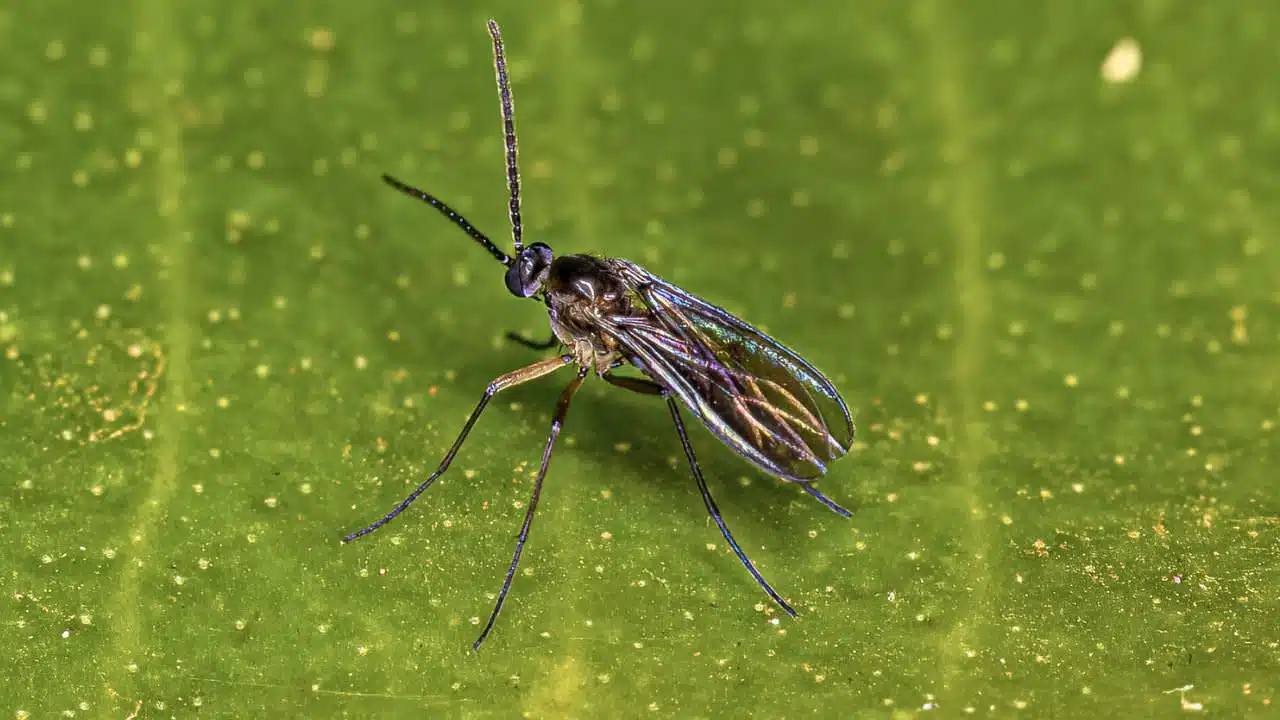
Fruit flies: These pests are typically attracted to overripe or fermenting fruit and other sugary substances, often found in kitchens rather than in soil. Fruit flies have more rounded bodies with shorter legs.
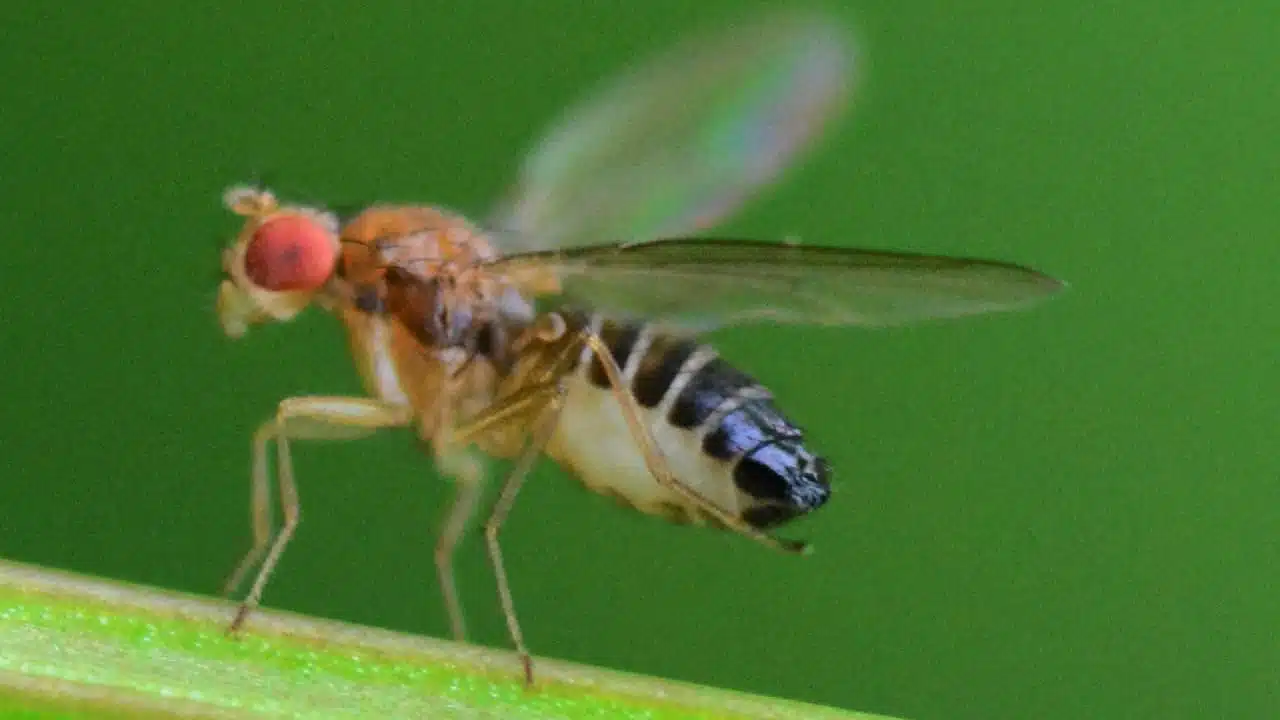
Mosquitoes: Mosquitoes are blood-feeding insects that breed in stagnant water outdoors, like ponds or buckets. These are generally larger than gnats and fruit flies, with elongated bodies and thin legs. They have a more robust build and are often darker in color.
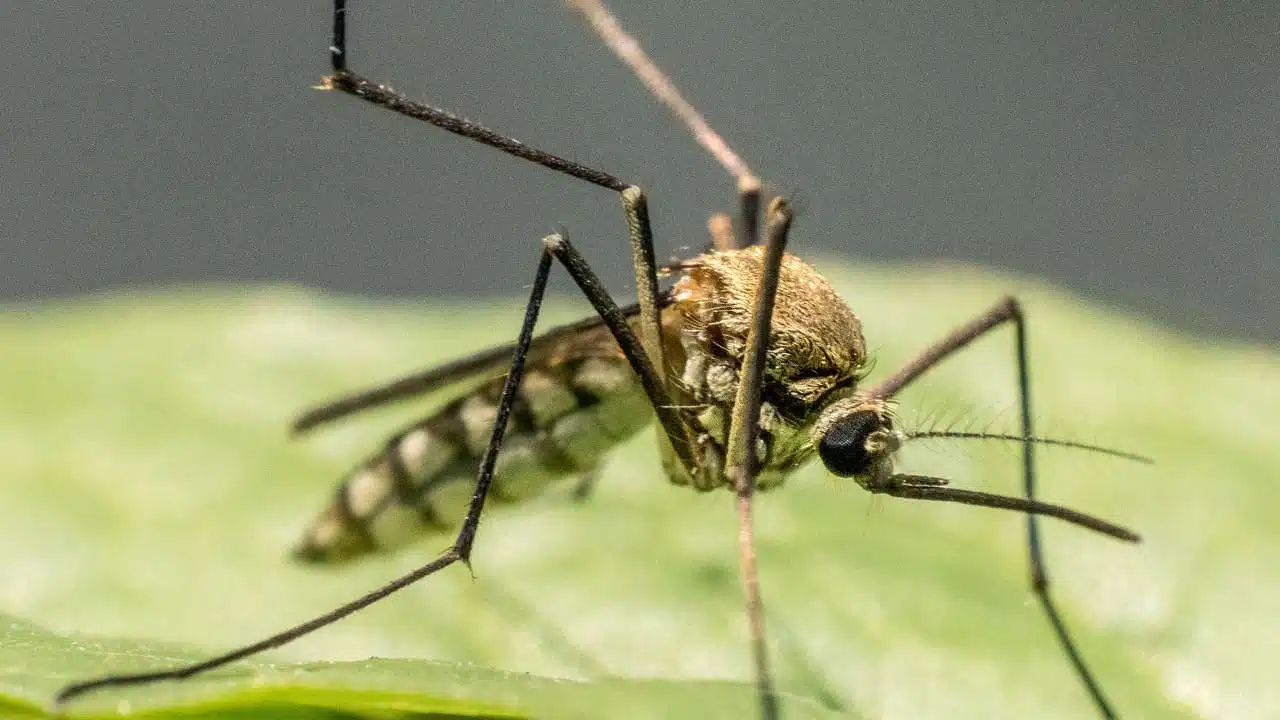
Overall, while gnats, fruit flies, and mosquitoes may share some similarities, their distinct appearances, habitats, and feeding habits help differentiate them from one another.
The Life Cycle Of Gnats
The life cycle of gnats encompasses four key stages:
Egg: Female gnats lay their eggs in the top layer of moist soil.
Larva: Upon hatching, the larva feeds on fungi and organic material in the soil.
Pupa: The larva then develops into a pupa, which eventually emerges as an adult gnat.
Adult: Adults live about a week, during which they reproduce and lay more eggs.
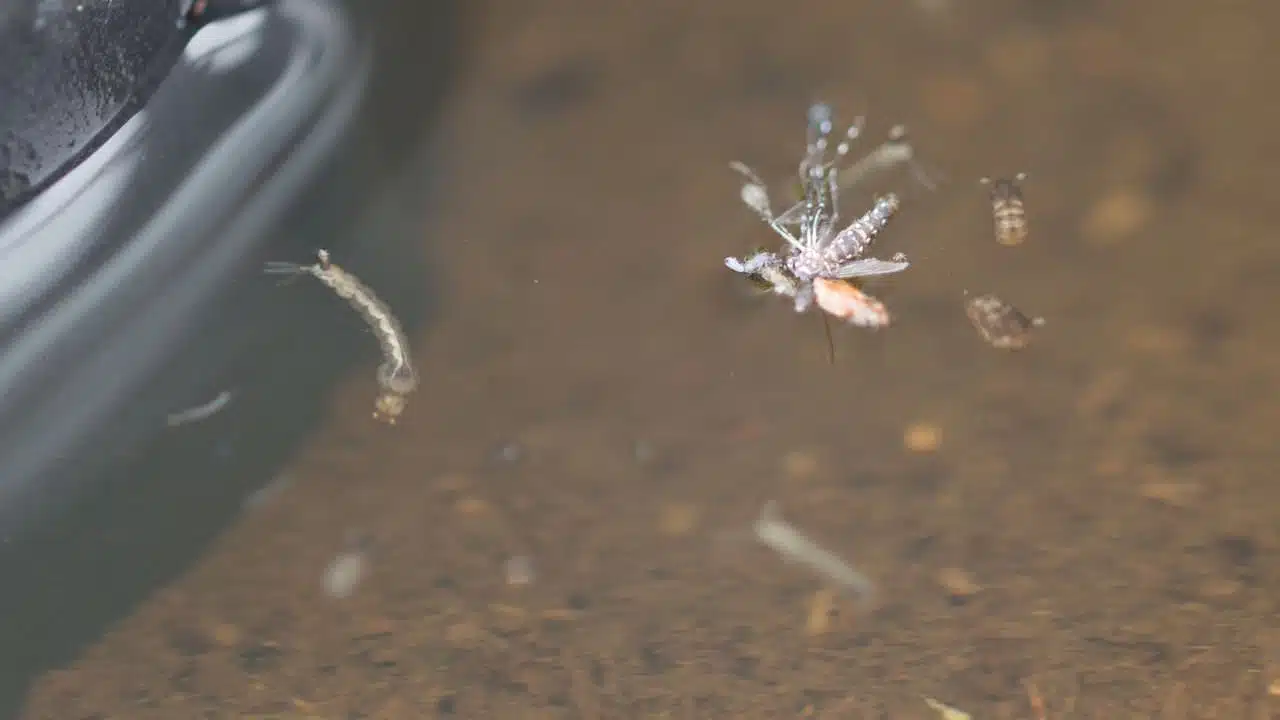
Understanding this cycle is crucial in timing interventions to break it.
Where Do Gnats Come From?
Gnats can appear seemingly out of nowhere, but they usually enter our homes due to certain attractants or through inadvertent introductions.
Here’s what you need to know about where gnats come from:
Outdoor To Indoor Migration
Gnats often originate from the outdoors.
They are attracted to homes for the same reasons they are drawn to nature: moisture and organic material.
Open windows, doors, and even vents can be gateways for gnats to enter from their natural outdoor habitats, such as garden mulch, compost piles, and damp areas under leaves.
Infested Plant Material
One of the most common ways gnats invade indoor spaces is through infested plant material.
When bringing new plants into your home, they might already be harboring gnat larvae or eggs in their soil, which can hatch and multiply very fast under suitable indoor conditions.
It’s always a good idea to quarantine new plants for a few days and inspect them for any signs of pests. This practice is an important step in learning how to get rid of gnats in plants, as it prevents the spread of these pests to your other houseplants.
Overwatering And Poor Drainage
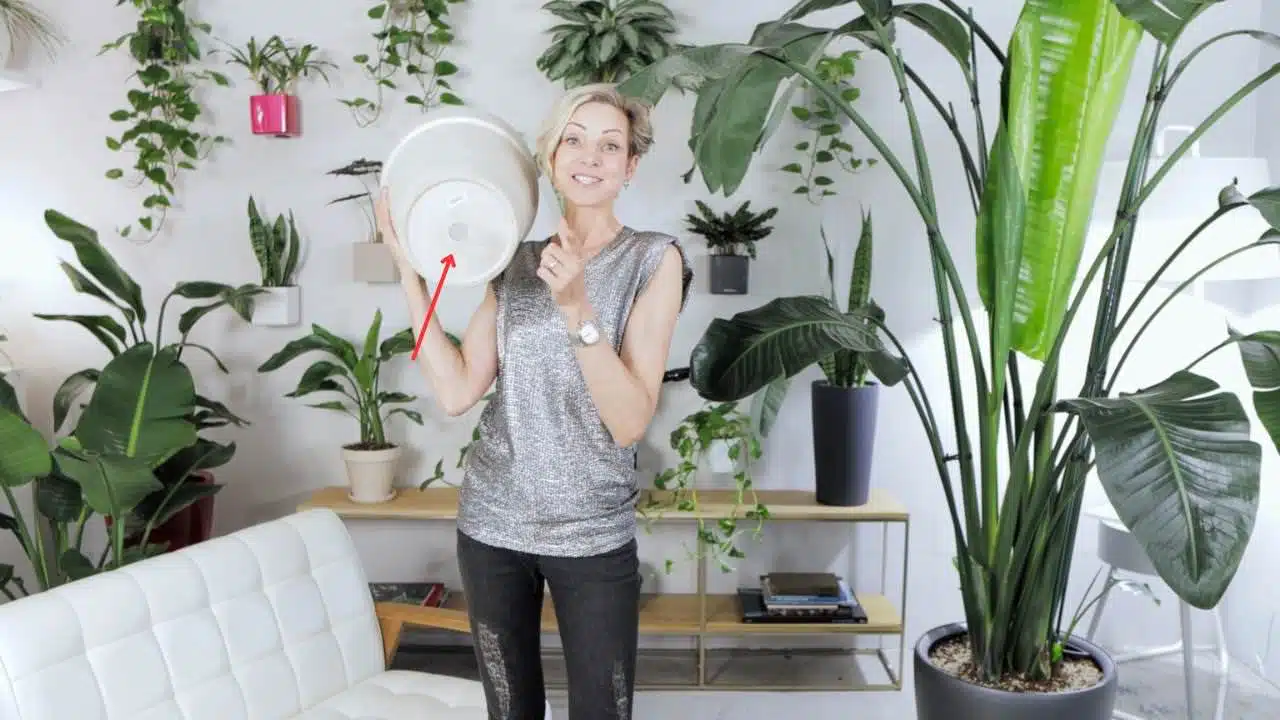
Creating an environment that gnats find irresistible is often the root cause of their presence.
Overwatering your plants can create pools of excess moisture in saucers and overly damp soil, which are ideal breeding grounds for fungus gnats.
Make sure your plants have adequate drainage and promptly eliminate any excess water.
Decomposing Organic Matter

Gnats are attracted to decomposing plant material, including old leaves and dead flowers.
Regularly cleaning up plant debris from the topsoil and surrounding areas can significantly reduce gnat attractants.
Also, be mindful of the organic matter content in your potting mix; overly rich soil can be too irresistible for gnats.
Through Purchased Soil Or Compost
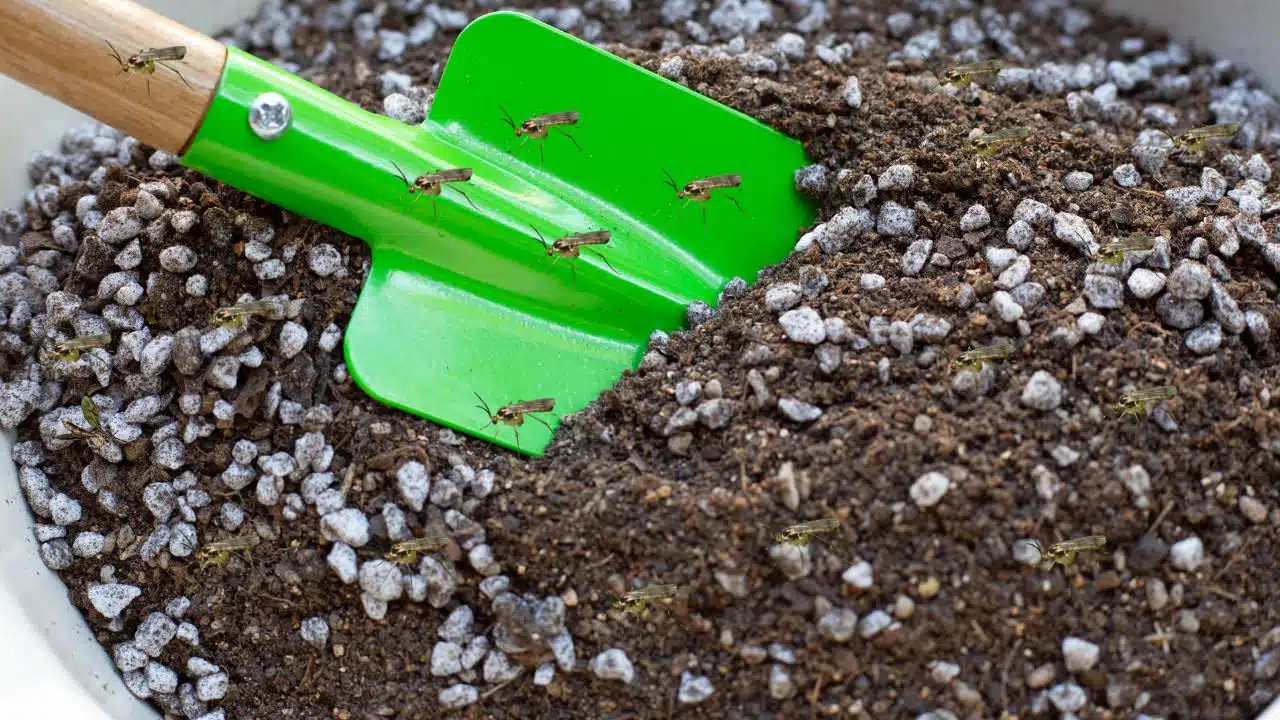
Sometimes, the potting mix itself can be a source of gnat problems. Bags of soil and compost that have been improperly stored, especially in a moist environment, can harbor gnat larvae.
Always purchase high-quality, well-packaged soil from reputable suppliers to minimize this risk.
By being aware of these common sources of gnats, you can take proactive steps to minimize the chances of these pests invading your indoor garden.
Identifying Gnat Infestations: First Steps On How To Get Rid Of Gnats In Plants
Recognizing the initial signs of a gnat infestation is very important for taking timely action to protect your houseplants.
It ensures that the infestation can be managed before it escalates and causes significant damage to the plants.
Signs Of The Fungus Gnat Infestation
Gnats display unique flight behaviors, often described as a type of “dance” above the soil or surrounding plants.
Regularly spotting small, dark-colored flies in the vicinity, particularly when watering houseplants, indicates a gnat issue to me.
How To Confirm Gnat Presence
To confirm that gnats are indeed infesting my plants, I perform the following steps:
Soil inspection: I carefully inspect the top layer of soil by gently disturbing it to observe if gnats will emerge.
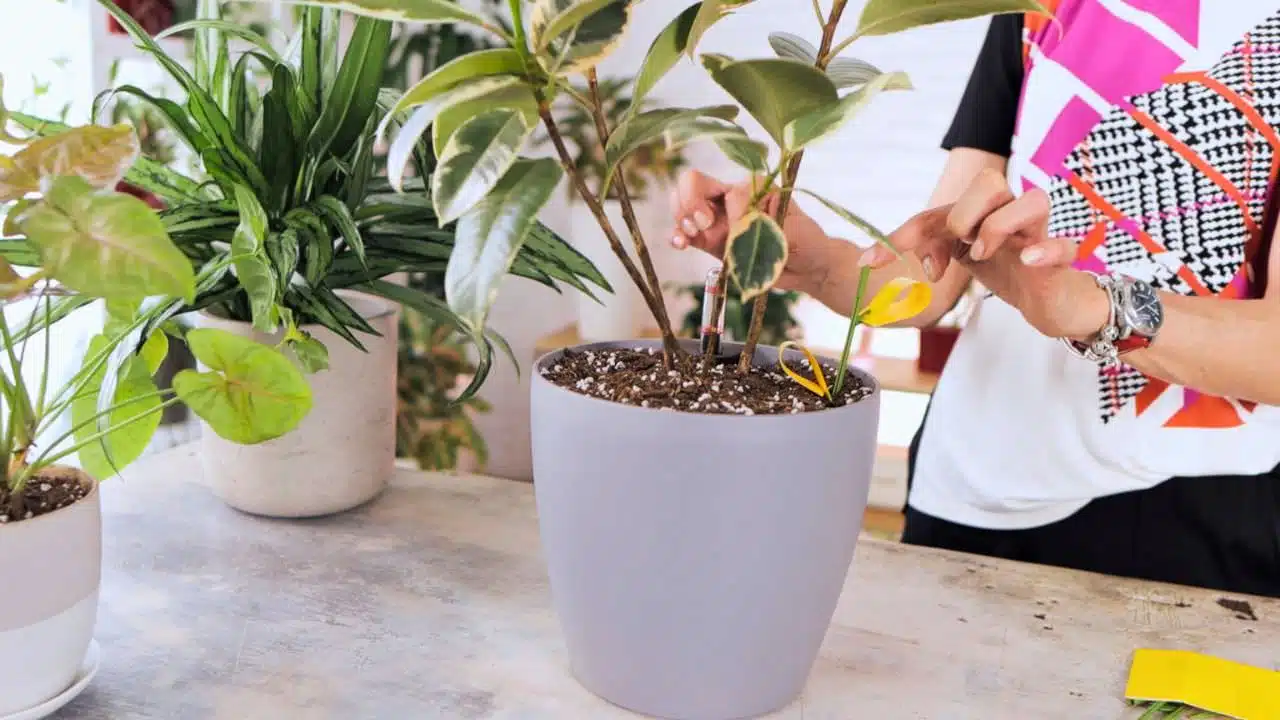
Yellow sticky traps: I place gnat sticky traps around my plants. If sticky traps become speckled with gnats, it strongly suggests that the plant where the gnats are caught in the trap is infested.
How To Determine The Severity Of A Gnat Infestation
A gnat infestation can range in severity, and understanding the signs can help you take the right action for your plants.
- Light Infestation: You may notice just a few gnats occasionally flying around your plants. It’s not overwhelming, and you might only see one or two every now and then. This stage is easy to manage if addressed promptly.
- Medium Infestation: Gnats are becoming more of a nuisance. You’ll see a noticeable number of them flying around your plants, and if you check the soil, you may spot tiny larvae wriggling just beneath the surface. At this point, it’s clear the gnats are multiplying, and your plants are at risk if left untreated.
- Heavy Infestation: The situation has escalated significantly. You’ll see large swarms of gnats in the air, and when you disturb the soil, larvae are visibly present throughout, often in large numbers. This level of infestation requires immediate intervention as it poses a serious threat to your plants’ health.
I’d love to know how severe your gnat problem is. Please choose from one of the options below 👇
My Gnat Treatment Strategies: How To Get Rid Of Gnats In Houseplants Effectively
Watch my video to learn how to replace the topsoil, repot, set traps, and test the soil to get rid of gnats in your plants. It’s from back when I didn’t know how to pronounce “gnat” correctly [it’s just “nat”!] 🤭
Alright, plant parents, let’s roll up our sleeves and get down to business!
I’ve got some tried-and-true remedies that’ll send those pesky gnats packing without harming your green babies. Trust me, I’ve used these methods countless times, and they work like a charm!
Light Gnat Infestation Treatment Strategy
Here’s what you’ll need to get rid of gnats in plants with light gnat infestation:
- gloves
- fresh soil
- gnat sticky traps
- soil moisture meter
- chopsticks
Topsoil Replacement
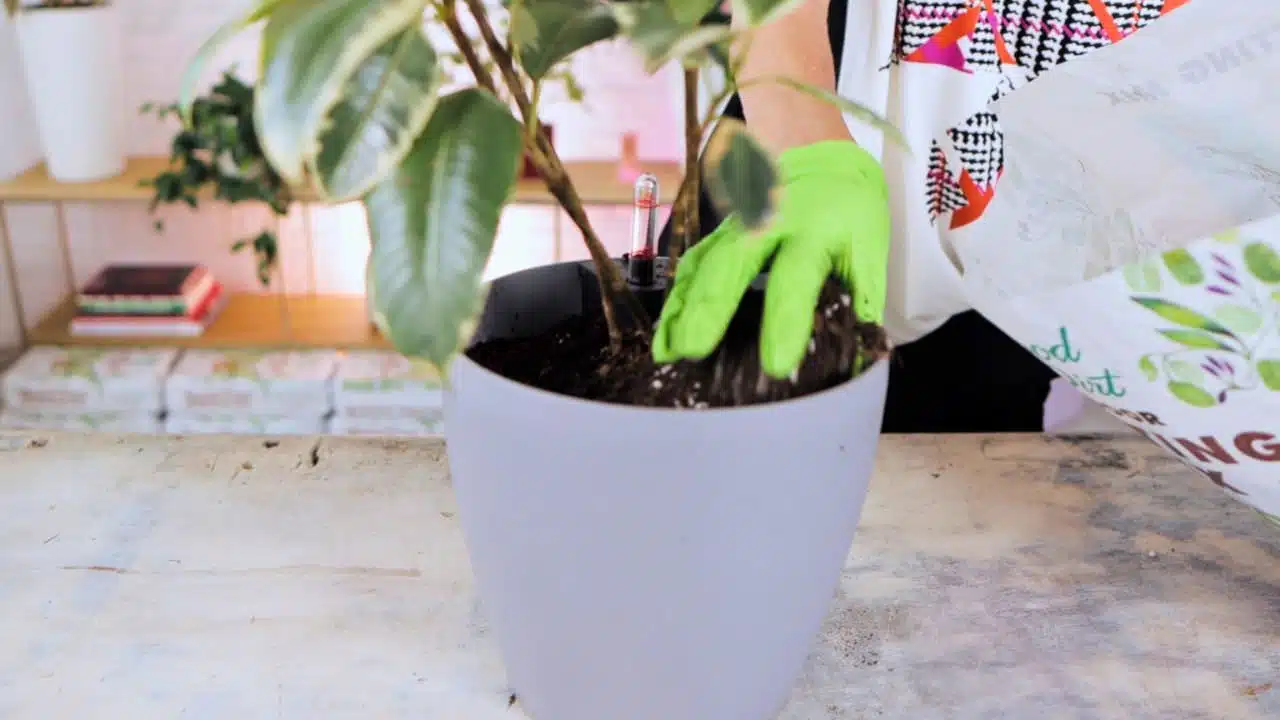
For a light gnat infestation, the solution starts with replacing the top layer of soil.
Carefully remove about three to four inches, ensuring any potential gnat eggs are scooped away.
Replace this with fresh, dry soil – moisture is the enemy here.
Gnat Traps
Gnat sticky traps are invaluable in the battle against these pesky insects.
Easy to assemble, they catch adult gnats, significantly reducing the chance of further egg-laying.
Place these traps around the infested plant and all other plants as a preventive measure.
Watering
It’s important not to water your plant until the soil is dry enough to prevent gnats from breeding and returning.
I use and strongly recommend using the Soil Moisture Meter. This tool will help you to prevent overwatering.
You just need one Soil Moisture Meter for all your plants.
Accelerating Soil Drying
To help the soil dry out faster, and thus discourage gnats further, aerate it using a simple chopstick.
Insert it deep into the soil, making big circular motions around the plant.

This loosens the soil, improves air circulation, and helps the soil dry out more quickly. Repeat this aeration process weekly until the soil feels dry.
Medium Gnat Infestation Treatment Strategy
Here’s what you’ll need to get rid of gnats in plants with medium gnat infestation:
What is Neem cake?
Neem cake, also known as neem meal, is a natural fertilizer and soil amendment made from the seeds of the neem tree.
Using a neem cake solution is a powerful and natural way to eliminate gnats from your plants.
Preparing the neem cake solution: Combine two to three heaping tablespoons of neem cake with one gallon of water, allowing it to steep for several hours or overnight but not longer than that.
Watering plants with neem cake solution: Utilize the neem solution during your standard watering schedule, ensuring thorough soil contact, particularly around the surface. You can opt for quick flooding to cover all areas or a slower application for comprehensive saturation.
Tips for effective application
Ensuring soil contact: When using neem solution, ensure the water reaches the root zone to expose gnats and larvae to neem properties.
Watering routine: Use neem cake solution for your regular watering routine for consistent application. Patience is key, as multiple waterings may be needed for effective gnat eradication.
Gnat traps: Place these traps around the infested plant and all other plants as a preventive measure.
Watch this video to learn how neem cake can help get rid of gnats in your plants 👇
Alternative To Neem Cake
Bonide Systemic Houseplant Insect Control is a highly effective chemical solution for getting rid of gnats. However, please note that it contains imidacloprid, which is restricted or prohibited in certain states, including New York, California, and others.
Imidacloprid belongs to a class of chemicals called neonicotinoids which act on the nervous system of insects.
This 8-ounce container of ready-to-use granules is both simple to use and effective for indoor and outdoor plants. Here’s how to apply it:
- Evenly spread the granules on top of the soil.
- Mix them thoroughly into the upper layer of soil.
- Water your plant to activate the product.
- Reapply every 8 weeks for continued protection.
I appreciate that it’s a low-odor solution, so there’s no need to worry about strong, unpleasant smells in your home. The granules are absorbed by the plant’s roots, distributing protection throughout the entire plant. This ensures that rain or watering won’t wash away its effectiveness.
Keep in mind that this product isn’t safe for edible plants, so if you’re growing herbs or vegetables, you’ll need a different solution.
If you’re dealing with pests on your houseplants, Bonide Systemic Houseplant Insect Control is a great option. It’s user-friendly and combats a range of common pests, including mealybugs, spider mites, aphids, whiteflies, and more.
Heavy Gnat Infestation Treatment Strategy: How to Get Rid of Gnats in Houseplants
Here’s what you’ll need to get rid of gnats in plants:
Reppoting
For heavy gnat infestation, repotting the plant in a fresh potting mix is the best.
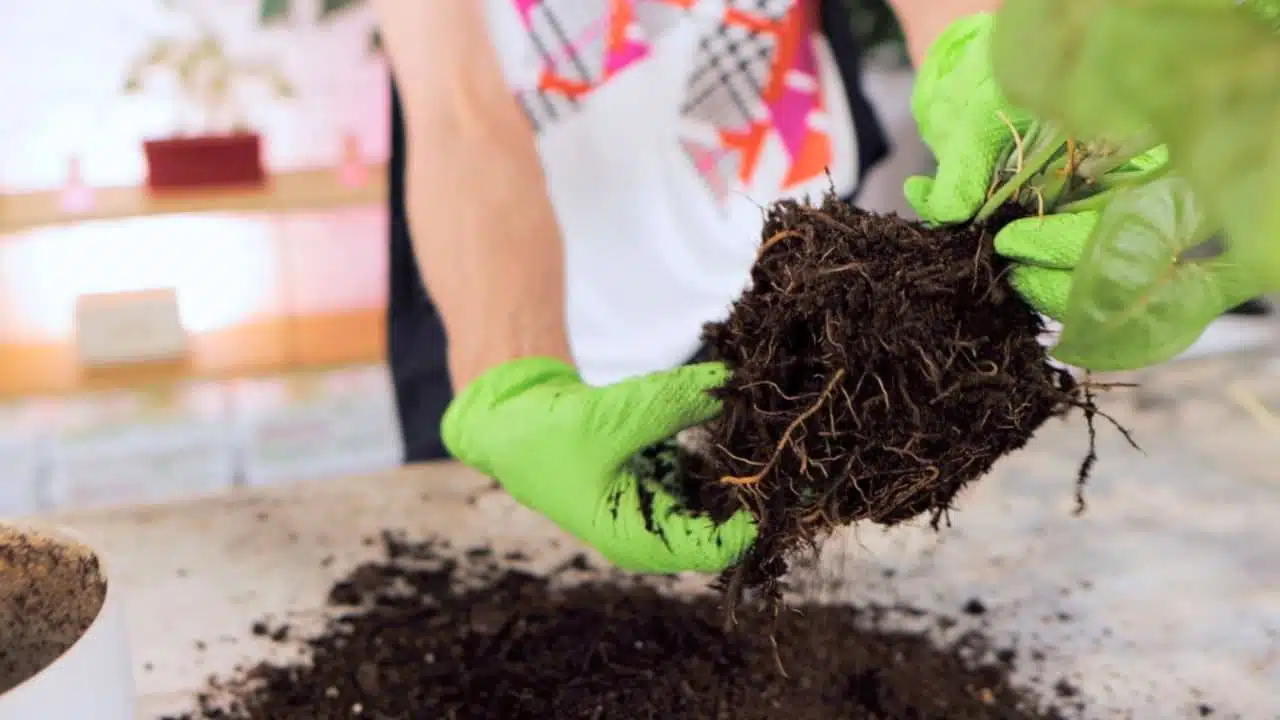
Carefully remove your plant, shake off the old soil, and inspect the roots.
Trim any brown, smooth roots, but if the majority are rotted, it may be too late.
Once cleaned, repot in fresh soil, ensuring it’s dry or only slightly moist.
If repotting your plant feels like a daunting task, you can skip directly to the next step: applying the neem cake solution.
Gnat traps: Place these traps around the infested plant and all other plants as a preventive measure.
Monitoring soil moisture levels
Regularly check your soil’s moisture level using either your finger or a soil moisture meter.
Water only when the soil is dry, which helps prevent gnats from making a comeback.
Check out my tutorial on using the Soil Moisture Meter to determine the right watering schedule for your plants and learn how to gauge if you’ve provided enough water to ensure your plants are properly hydrated.
For pots with drainage holes, I advocate for the bottom watering method, which ensures the plant receives moisture directly to its roots without excessively saturating the topsoil.
Air circulation
Air circulation plays a crucial role in combating or preventing gnat issues.
Improved airflow can help to dry out the soil more quickly, reducing the moisture levels that gnats are attracted to.
Better air circulation can promote the growth of beneficial microorganisms in the soil, which can outcompete gnat larvae for resources, thereby helping to control their population.
Overall, good air circulation is an essential component of an integrated approach to managing gnat problems in indoor environments.
Other natural remedies for eliminating gnats
If my methods for getting rid of gnats in plants aren’t working well for you, don’t worry—there are other natural remedies you can try. These are options I’ve used in the past with some success, although the strategies I’ve shared above have proven to be the most effective for me.
Hydrogen Peroxide Soak: The Bubble Bath of Doom
First up, let’s talk about the hydrogen peroxide soak.
Here’s what you do: mix 1 part hydrogen peroxide with 6 parts water. Now, wait until your plant’s soil is nice and dry, then give it a good drench with this bubbly solution.
Why does this work? Well, the hydrogen peroxide creates a hostile environment for those gnat larvae, effectively drowning them. Plus, it’s actually good for your plants! It oxygenates the soil and can even help prevent root rot. Talk about a win-win!
Neem Oil: Nature’s Pest Control
Next up is neem oil, a natural pesticide that’s been used for centuries. I love this stuff because it’s safe for humans and pets but absolutely devastating to pests.
Mix about 10ml of neem oil with 1 liter of water. Add a tiny drop of dish soap to help it emulsify, then spray this solution on the soil surface and the plant itself.
The great thing about neem oil is that it doesn’t just kill the larvae – it also disrupts the life cycle of the adult gnats. It’s like putting up a “No Vacancy” sign for future generations of gnats!
Mosquito Dunks: The Secret Weapon
Now, let me introduce you to mosquito dunks. These little tablets contain a bacteria called Bacillus thuringiensis israelensis (BTI), which is deadly to gnat larvae but harmless to plants and humans.
Here’s what I do: I crumble up a mosquito dunk and mix it into my watering can. Then, I water my plants as usual. The BTI gets into the soil and takes care of those pesky larvae before they can do any more damage. It’s like having a tiny army of gnat assassins in your soil!
Traps to Capture Adult Gnats
Alright, plant pals, let’s talk about catching those pesky adult gnats! While we’ve been focusing on the larvae, we can’t forget about those annoying flyers. I’ve got some tried-and-true trap methods that’ll have those gnats checking in but never checking out!
Sticky Traps
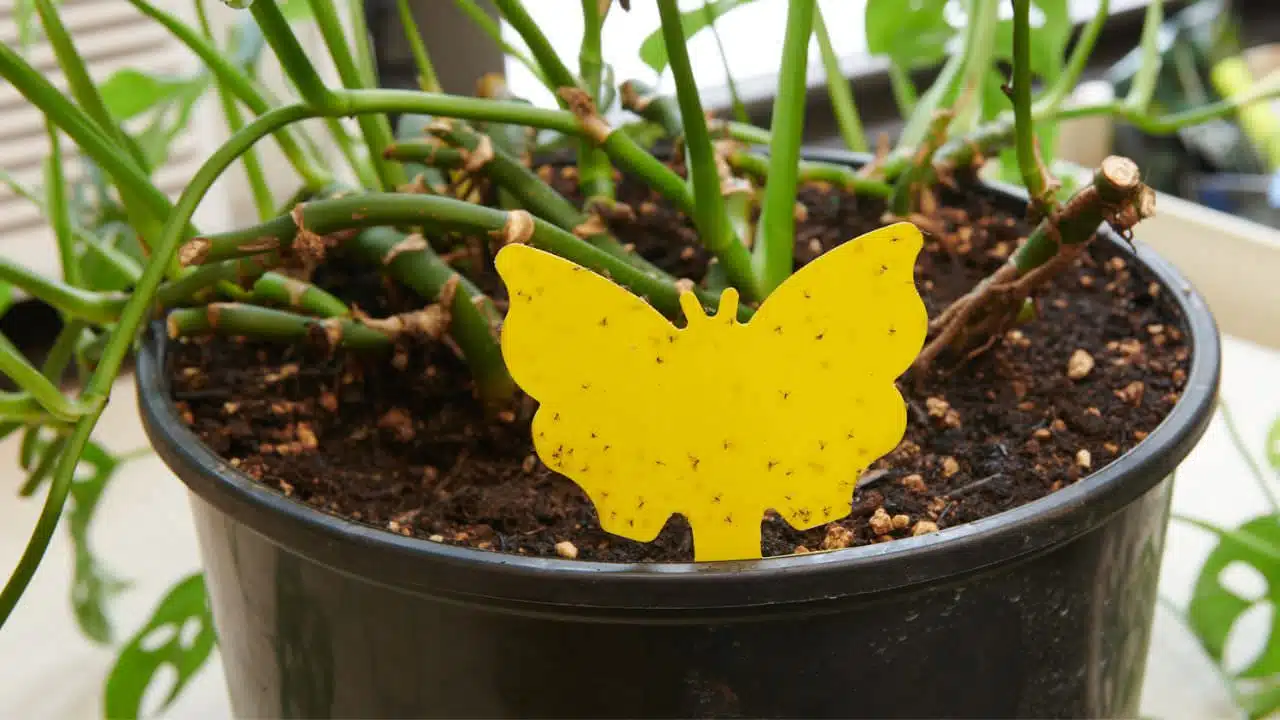
I’ve already mentioned these simple and inexpensive traps in my strategies for getting rid of gnats in plants. They’re my go-to solution for a quick and easy fix and an essential tool when tackling a gnat problem.
Sugar and Dish Soap Trap: A Sweet Surprise
Now, let me share one of my favorite DIY traps. I call it the sugar and dish soap special. Here’s what you do: mix a tablespoon of sugar, a few drops of dish soap, and some water in a shallow dish. Place this near your affected plants, and watch the magic happen!
The sugar attracts the gnats, but once they land on the water, the dish soap breaks the surface tension, and they sink. It’s like a sweet little pool party that turns into a gnat’s worst nightmare!
Cider Vinegar Trap: The Irresistible Lure
Last but not least, we’ve got the cider vinegar trap. This one’s super easy. Just fill a small container with apple cider vinegar and a drop of dish soap. Cover it with plastic wrap and poke a few tiny holes in the top.
The gnats can’t resist the smell of the vinegar, and they’ll find their way in through the holes. But once they’re in, they can’t get out. It’s like a funky-smelling gnat hotel with no vacancy!
Remember, while these traps are effective at catching adult gnats, they’re only part of the solution. To completely get rid of gnats, you’ll need to use these traps along with the other methods we’ve discussed.
Beyond pests: the emotional toll of battling gnats in your home

One of the most heart-wrenching aspects of my interaction with all of my viewers and customers has been hearing about the personal struggles and the emotional toll that battling gnats has taken.
I’ve heard from many who have felt overwhelmed and even brought to tears by ongoing gnat problems, about frustrations and setbacks, and it’s clear that this isn’t just about plant care—it’s about the peace of your home environment.
Remember, it’s okay to feel frustrated. What’s important is not to lose hope.
Implementing systematic changes like improving air circulation around your plants, using water wisely, and ensuring your pots have good drainage can make a big difference.
Safe Pest Control Methods: How to Get Rid of Gnats in Plants Safely
Safety is paramount, especially for those of you with pets or small children at home.
When setting up gnat traps, make sure they are placed where they won’t be a hazard to curious pets.
Opt for natural and safe solutions like neem cake solution, which can deter gnats without harming your plants or your home environment.
Shared experiences and community advice
Many of you have also shared your own successful strategies, which have worked wonders.
These community tips are invaluable, and I encourage everyone to keep sharing in the comments below.
Remember, we’re in this together, and sharing our experiences can lead to new solutions that we might not have considered alone.
Consistency is key
Winning against gnats requires consistency and vigilance. Keep monitoring and adjusting your watering habits, and employ preventive measures like gnat traps.
The health of your plants is in your hands. With a little effort and the right approach, you can eliminate gnats and prevent them from returning.
Common Questions and Answers
What is the fastest way to eliminate gnats from indoor plant soil?
The quickest way to eliminate gnats is to dry out the top layer of soil, as gnats thrive in moisture. Use Neem Cake solution to water your plants to target eggs and larvae without harming them.
What natural remedies can I use to remove gnats in my houseplants?
Natural remedies include using gnat traps to catch adult gnats and using Neem Cake solution to water plants which are non-toxic and very effective. Allowing the soil to dry between waterings can prevent gnat issues from recurring.
What can I do about my Lucky Bamboo that grows in water to prevent gnats?
Change the plant’s water at least once a week to avoid stagnant water. Wash roots well before placing them back in fresh water. Keep the air moving with fans.
Won’t aerating the soil cause the gnats to go deeper into the soil?
In my experience, soil aeration helps with the gnat issue by allowing oxygen to get through and drying soil faster, eliminating the environment for gnats to breed in.
Are gnats harmful to humans or pets?
Gnats are generally not harmful to humans or pets in terms of causing direct physical harm. However, their presence can be irritating and annoying, particularly when they fly around faces or food. While they’re often found around houseplants, including pet friendly plants like Spider plants and Boston ferns, it’s essential to address any underlying issues, such as excessive moisture or decaying organic matter, as they can attract other pests or contribute to mold growth, which could potentially pose health risks.
To learn more about other plant pests and treatments check these blog posts:
How to get rid of Spider mites
How to get rid of Scale on houseplants



